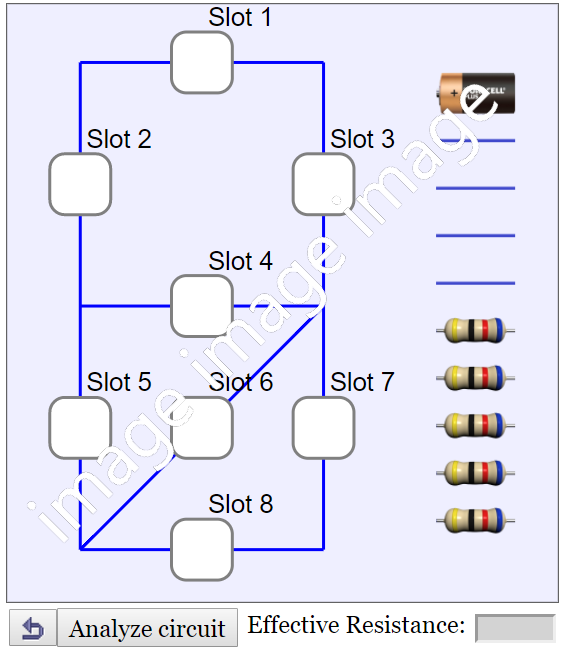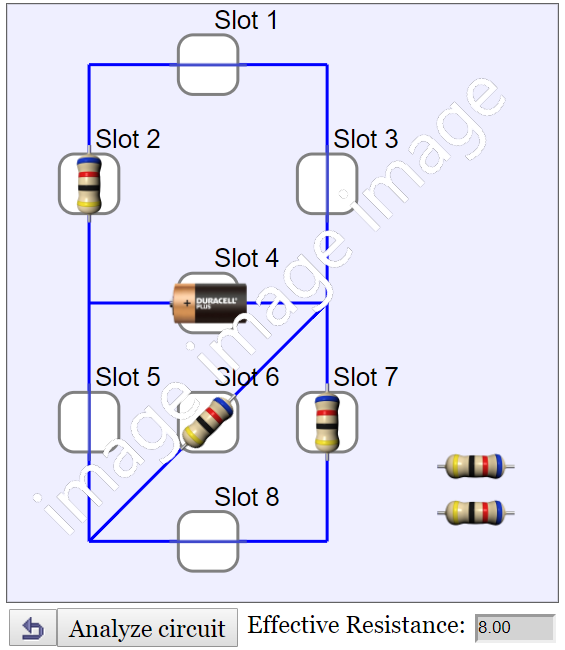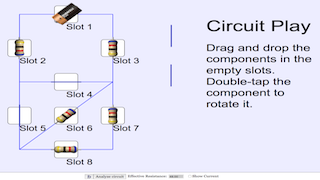About
Circuit Play
- Drag and drop the wires, cell and 24 Ohm resistors into the empty slots.
- Double-tap to rotate the component.
- Analyze the circuit to get the effective resistance.


This is a simulation of a simple direct current (D.C.) circuit. By putting wires and resistors at the slots, the effective resistance of the circuit can be analysed and calculated. There are a total of 8 slots to be connected with a choice of 10 components including one battery, four wires and five resistors.
The resistance in the battery and the wires is assumed to be zero ohm.
In order to connect the components correctly, double-tap a component to change its orientation. Each double-tap will rotate the component 45 degree counterclockwise. A component's orentation affects its connection with the rest of the circuit.
The effective resistance of n resistors connected in series can be calculated using the following equation:
Reff = R1 + R2 + R3 + ... + Rn
The effective resistance of n resistors connected in parallel can be calculated using the following equation:
Reff = 1 / (1/R1 + 1/R2 + 1/R3 + ... + 1/Rn)
Translations
| Code | Language | Translator | Run | |
|---|---|---|---|---|
 |
||||
Credits
 Francisco Esquembre; Kay Shin Tan
Francisco Esquembre; Kay Shin Tan
Subject: Analysis of "DC Circuit JavaScript Simulation Applet HTML5 by Tan KS" from Open Educational Resources / Open Source Physics @ Singapore
1. Overview
This document analyzes a webpage describing an interactive JavaScript simulation of a simple DC circuit. The simulation, developed by Tan KS, is designed as an open educational resource, allowing users to build and analyze basic circuits using virtual components. The resource is hosted on the Open Educational Resources / Open Source Physics @ Singapore platform.
2. Main Themes
- Interactive Learning: The primary theme is the use of an interactive simulation to teach fundamental concepts of DC circuits. The applet allows users to physically (virtually) construct circuits, promoting hands-on engagement.
- Visual Representation: The simulation provides a visual, intuitive way to understand abstract concepts like resistance, current flow, and series/parallel connections.
- Conceptual Understanding: The simulation is explicitly designed to address common student misconceptions about electricity.
- Open Educational Resource (OER): The resource is freely available and encourages sharing and reuse in educational settings, aligning with OER principles.
3. Key Features and Functionality
- Component Manipulation:Users can drag and drop components (wires, battery, resistors) into designated slots.
- Components can be rotated through double-tapping, allowing for different circuit configurations.
- The simulation includes 10 components, including a battery, wires, and resistors, that can be dragged and dropped to form a closed circuit, if desired.
- Circuit Analysis: The simulation facilitates the analysis of circuit resistance.
- The effective resistance of series circuits can be calculated using the formula: Reff = R1 + R2 + R3 + ... + Rn
- The effective resistance of parallel circuits can be calculated using the formula: Reff = 1 / (1/R1 + 1/R2 + 1/R3 + ... + 1/Rn)
- Simplified Model: The simulation assumes zero resistance in the battery and wires, simplifying the calculations and focusing on the impact of resistors.
4. Educational Goals and Addressing Misconceptions
The applet is explicitly designed to address common misconceptions about DC circuits:
- Misconception 1: Students believe that "current is 'used up' in a circuit." The simulation demonstrates that current is the flow of electrons already present in wires and that electric potential is the driving force, not that electrons are created or consumed as they travel through a circuit:
- "student believe that current is “used up” in a circuit, when in fact it is the electric potential that causes the flow of electrons, where electrons is always present in the wires."
- Misconception 2: Students think "the current through a battery will always have the same value, regardless of the number or configuration...of components." The simulation clarifies that current varies based on circuit connections:
- "student believe the current through a battery will always have the same value, regardless of the number or configuration (series or parallel) of components in the circuit, when in fact current can vary according to the circuit connections."
- Misconception 3: Students inappropriately use the terms current, voltage, energy, and power interchangeably.
- "Students referred to current, voltage, energy, and power inappropriately and sometimes interchangeably. 1. Failure to distinguish between voltage and current 2. Failure to apply concept of complete circuit and current flow correctly"
The document aims to address these by creating a simulation where students can manipulate the components to see that these terms all have different effects on an electrical circuit. The simulation can help students understand how current flows through closed circuits and how changing the structure of the circuit can affect the total resistance and the current in the circuit.
5. Technical Details
- Technology: The simulation is built using JavaScript and HTML5, making it accessible on modern web browsers without requiring additional plugins.
- Embeddability: The simulation is designed to be easily embedded into other websites using an <iframe> tag:
- <iframe width="100%" height="100%" src="https://iwant2study.org/lookangejss/00workshop/2017FelixPaco/day4/ejss_model_CircuitPlay/CircuitPlay_Simulation.xhtml " frameborder="0"></iframe>
- Credits: The simulation is credited to Francisco Esquembre and Kay Shin Tan.
6. Related Resources
The page links to a vast collection of other interactive educational resources created by the same organization, including:
- Many other physics simulations, both 2D and 3D using webGL technology
- Mathematics simulations
- Chemistry simulations
- Simulations for various other STEM subjects
This suggests a broader commitment to open educational resources and interactive learning tools.
7. Licensing The resources are released under a Creative Commons Attribution-Share Alike 4.0 Singapore License and commercial use of EasyJavaScriptSimulations Library is contingent upon contacting This email address is being protected from spambots. You need JavaScript enabled to view it..
8. Conclusion
The "DC Circuit JavaScript Simulation Applet" is a valuable resource for teaching basic DC circuit concepts. Its interactive nature, combined with explicit attention to common misconceptions, make it a helpful tool for both students and educators. The simulation supports effective learning of electrical circuits through manipulation and analysis. Its OER status makes it widely accessible for educational purposes.
DC Circuit Simulation Study Guide
Short Answer Quiz
- What is the primary function of the DC circuit simulation applet?
- How can you change the orientation of a component in the simulation?
- What does the simulation assume about the resistance in the wires and battery?
- How do you calculate the effective resistance of resistors connected in series?
- How do you calculate the effective resistance of resistors connected in parallel?
- According to the resource, what is a common misconception about current in a circuit?
- What is another common misconception about the current through a battery?
- What is a common mistake students make when discussing electrical concepts like voltage, energy and power?
- What two concepts do students often fail to distinguish?
- What other science topics are covered by simulations in this resource?
Answer Key
- The DC circuit simulation applet allows users to build and analyze simple direct current circuits using wires, resistors, and a battery, calculating the effective resistance.
- You can change the orientation of a component by double-tapping on it; each double-tap rotates the component 45 degrees counterclockwise.
- The simulation assumes that both the wires and battery have zero resistance.
- The effective resistance of resistors in series is calculated by summing their individual resistances: Reff = R1 + R2 + R3 + ... + Rn.
- The effective resistance of resistors in parallel is calculated using the reciprocal formula: Reff = 1 / (1/R1 + 1/R2 + 1/R3 + ... + 1/Rn).
- A common misconception is that current is "used up" in a circuit, when in reality it is electric potential that causes the flow of electrons.
- Students may believe the current through a battery is constant regardless of circuit configuration, but it changes based on connections.
- Students often use the terms current, voltage, energy, and power inappropriately, sometimes interchangeably.
- Students often fail to distinguish between voltage and current.
- Other science topics covered by simulations in the resource include projectile motion, wave phenomena, magnetic fields, atomic structure, and others.
Essay Questions
- Discuss the pedagogical value of using simulations like the DC Circuit applet for learning about electrical circuits. How does the interactive nature of the simulation address the common student misconceptions about current and voltage?
- Compare and contrast series and parallel circuits. Using specific examples from the simulation, explain how the total resistance of each circuit is calculated, and discuss how the placement of resistors affects the current flow.
- Analyze the design choices made in creating the DC Circuit Simulation applet. How does the interface, with its drag-and-drop features and visual representation of circuit elements, contribute to or detract from the learning process?
- Based on the "Alternate Concepts" section, what are the primary challenges students face when learning about basic circuits? How could these challenges be addressed through the design and implementation of educational tools?
- Explore the broader context of the OER resource, including the variety of simulations listed. Discuss how these simulations, encompassing various scientific disciplines, collectively contribute to a more comprehensive and interactive learning environment.
Glossary of Key Terms
- DC Circuit: A direct current circuit in which the electric current flows in one direction.
- Resistance: A measure of how much a material impedes the flow of electric current, measured in ohms.
- Effective Resistance: The total resistance of a circuit or a portion of a circuit.
- Series Circuit: A circuit in which all components are connected end-to-end, forming a single path for current flow.
- Parallel Circuit: A circuit in which the components are connected side-by-side, providing multiple paths for current flow.
- Current: The rate of flow of electric charge, usually electrons, measured in amperes.
- Voltage: The electric potential difference between two points, measured in volts. It is the driving force for current flow.
- Electric Potential: The potential energy per unit of charge at a given point. It drives the current in the circuit.
- Ohm: The unit of electrical resistance.
- Simulation Applet: A software program that models a real-world phenomenon or process, typically interactively.
- Open Educational Resource (OER): Educational materials that are freely available for anyone to use, adapt, and share, often under a Creative Commons license.
Alternate Concepts
- student believe that current is “used up” in a circuit, when in fact it is the electric potential that causes the flow of electrons, where electrons is always present in the wires.
- student believe the current through a battery will always have the same value, regardless of the number or configuration (series or parallel) of components in the circuit, when in fact current can vary according to the circuit connections.
- Students referred to current, voltage, energy, and power inappropriately and sometimes interchangeably.
- Failure to distinguish between voltage and current
- Failure to apply concept of complete circuit and current flow correctly
Version
Other Resources
[text]
FAQ
- What is the purpose of the DC Circuit JavaScript Simulation Applet?
- This simulation applet allows users to explore and analyze simple direct current (DC) circuits. Users can drag and drop components like wires, resistors, and a battery into designated slots, and then examine the resulting circuit's effective resistance. It is designed to provide a hands-on learning experience with the fundamental concepts of DC circuits.
- How do I interact with the components in the simulation?
- To interact with the components, you can drag and drop them into the available slots. To change a component's orientation (which is crucial for correct circuit connections), you can double-tap it. Each double-tap rotates the component 45 degrees counterclockwise. The battery and wire components have no resistance, but the resistor components have a resistance of 24 ohms each.
- How is effective resistance calculated for series and parallel circuits in the simulation?
The applet uses standard physics formulas to calculate effective resistance. For resistors connected in series, the effective resistance (Reff) is the sum of individual resistances (Reff = R1 + R2 + R3 + ... + Rn). For resistors in parallel, the effective resistance is calculated using the reciprocal of the sum of the reciprocals of individual resistances: Reff = 1 / (1/R1 + 1/R2 + 1/R3 + ... + 1/Rn).
- What are some common misconceptions about circuits that this simulation aims to address?
- The simulation aims to counteract common student misconceptions such as: 1) the idea that current is "used up" in a circuit instead of the electric potential causing electron flow, and 2) the belief that the current through a battery remains constant regardless of the circuit's configuration. Students also have difficulty distinguishing between voltage and current.
- Why is the orientation of components important in this simulation?
- The orientation of the components is critical because it determines how they connect within the circuit. Incorrect orientations will result in an incomplete circuit or an unintended circuit configuration, thus affecting the final results and providing a visual representation of the importance of proper connections.
- What components are available for use in the simulation and how are they used?
- The simulation provides one battery, four wires, and five 24-ohm resistors. These components can be placed into a total of eight available slots within the simulation. The wires are assumed to have zero resistance and the resistors each have 24 ohms of resistance. The battery provides the voltage to cause the flow of electrons. The orientation of components must be managed by the user, in order to create a correct and functional circuit.
- Is this simulation part of a larger collection of educational resources?
- Yes, this DC Circuit simulation applet is part of a larger collection of Open Educational Resources / Open Source Physics @ Singapore. The website also features other simulation applets covering topics in physics, chemistry, and mathematics. Other interactive simulations cover topics such as projectile motion, radioactive decay, and electromagnetism. This suggests that the simulation is part of a suite of interactive learning tools.
- Who are the creators of this simulation, and how can I use it?
- This specific DC Circuit simulation applet was created by Tan KS, with Francisco Esquembre and Kay Shin Tan listed in the credits. The simulation is embeddable and can be freely integrated into web pages for educational use. It is intended for the purpose of teaching and learning, and is licensed under Creative Commons Attribution-Share Alike 4.0 Singapore License. For commercial uses of the underlying EasyJavaScriptSimulations Library, the appropriate parties should be contacted.
- Details
- Written by Fremont
- Parent Category: 05 Electricity and Magnetism
- Category: 05 Circuits
- Hits: 10358








